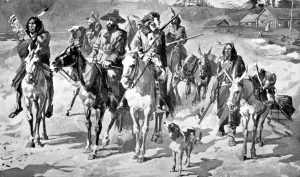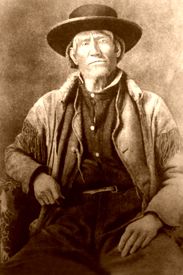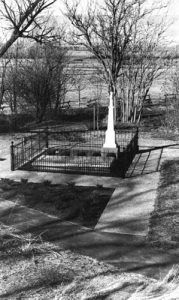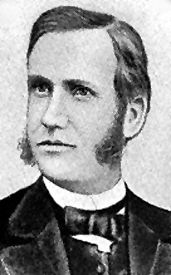
Dr. Marcus Whitman
A physician and missionary in Oregon Country, Dr. Marcus Whitman and his wife, Narcissa, were among the first American settlers in the West. In 1836, they started a mission to the Cayuse Indians in southeastern Washington state. The area later developed as a trading post and stop along the Oregon Trail, and the Whitmans would play an important role to the many westward-bound pioneers.
On September 4, 1802, Marcus Whitman was born to Beza and Alice Whitman in Federal Hollow (later Rushville), New York. He was the seventh generation of “descendants of John Whitman” who arrived in the Massachusetts Bay Colony sometime before December 1638. His father, Beza died when he was seven years old, and the boy was sent to live with an uncle in Massachusetts, where he received education and a moral upbringing for five years.
His teenage years were spent in Plainfield, Massachusetts, at a school taught by Reverend Moses Hallock. When Marcus was 17 years old, he was greatly influenced by religious revivals throughout New England, now known as the “Second Great Awakening.” The following year, in 1820, he returned to Rushville, New York, and told his family of his wishes to become a minister. However, they were not supportive of this goal as it took seven years to become a minister – four years of college, followed by three years in a theological seminary. Instead, he worked in his stepfather’s tannery and shoe business for the next three years. At age 21, he began studying to be a doctor, apprenticing himself to a local physician.
In 1825, he enrolled in the College of Physicians and Surgeons of the Western District of New York in Fairfield. After just 16 weeks, he was qualified for a license to practice medicine. He then went to Canada to practice medicine, spending about 2 ½ years in the Niagara District before returning to Rushville. By this time, his thoughts had again turned to ministry, and he entered preparatory study to become a minister. His studies for the ministry were cut short by illness and never completed. In October 1831, he again entered the College of Physicians and Surgeons at Fairfield and achieved his Medical Doctor (M.D.) degree.
Afterward, he settled in Wheeler, New York, where he became an active community member and was elected to be a trustee of the Wheeler Presbyterian Church in 1832 and 1833. He was ordained as an elder of the church in 1834. It was also in 1834 that Marcus Whitman was brought to the attention of the American Board of Commissioners of Foreign Missions (ABCFM) in Boston, Massachusetts. The ABCFM was an organization that sponsored Presbyterian and Congregational missions worldwide. The Reverend H.P. Strong of Rushville wrote the ABCFM on April 25, 1834:
I write at this time to make known to you the request of Doctor Marcus Whitman. He is a young man of about 30 or 35 years of age, of solid, judicious mind, of, as I hope and believe, more than ordinary piety and perseverance, a regular bred Physician, has practiced several years with good success and credit. He is, in my opinion well qualified to act as a Missionary Physician. Although I know not that he thinks of it, yet I think he might, if thought expedient after a time, be ordained to advantage. He has formerly been in poor health, but is now better, and thinks a station with some of our western Indians would be useful to him. He has thought of being a Missionary for some time past, and I think him better qualified to do good in that capacity than most young men with whom I am acquainted. He would be glad to hear from you soon, as, should he go, he would have some worldly concerns to arrange.
Yours Respectfully,
Henry P. Strong
The ABCFM replied to this letter to Reverend Strong, who then communicated with Dr. Whitman, resulting in Whitman writing the American Board in June 1834:
“I regard the Missionary cause as based upon the Atonement, and the commands and promises of the Lord Jesus Christ to his Ambassadors and Church; and that it involves the holiness and happiness of all that may be reclaimed from Sin. I regard the Heathen as not having retained the knowledge of the true God and as perishing as described by St. Paul. I esteem it the duty of every Christian to seek the advancement of the cause of Christ more truly than they are wont to their own favorite objects. I pray that I may have only such feelings in desiring to be received as a helper in the Missionary Cause. I am ready to go to any field of usefulness at the direction of the A. Board. I will cooperate as a Physician, Teacher, or Agriculturalist so far as I may be able if required. I am not married and I have no present arrangement upon that Subject. Yet I think I should wish to take a wife if the service of the Board would admit. I am in my thirty-second year. My mind has long been turned to the missionary subject. For the last six months, I have been more intent upon it than before. I wish soon to have a definite course.
Yours in Christian fellowship,
Marcus Whitman”
Due to the ill health that had prevented Marcus from completing his ministerial studies, the ABCFM was hesitant to accept him as a missionary and did not appoint him despite letters assuring them that his health had improved. Later in 1834, Marcus again had letters written on his behalf to the ABCFM to become a medical missionary. On January 6, 1835, the Board met and appointed Dr. Whitman as a missionary doctor. His appointment began with orders to accompany Samuel Parker to the Rocky Mountains that summer and scout out mission lands. Marcus settled affairs in Wheeler and set out to acquire the last thing missing in his life – a wife.
Marcus may have previously been acquainted with Narcissa Prentiss before his February 1835 visit to her family’s home that ended with his marriage proposal. At that time, some missionary couples were introduced by mutual acquaintances for what seems to us today to be a marriage of convenience, the individuals hardly knowing one another, but having common morals and goals. Narcissa Prentiss was from Amity, New York. She had also applied to the American Board of Commissioners of Foreign Missions but was told that unwed females were not accepted. Her prayers were answered when Marcus Whitman entered her life. Narcissa accepted Marcus’ proposal, and they both had a year to anticipate their marriage while Marcus made his journey west for the first time with Samuel Parker.
The journey west with Parker was not a pleasant one. Mr. Parker was very difficult and considered Whitman more of a servant than an associate. They traveled with a caravan heading to the annual Rendezvous of mountain men and trappers held on the Green River in present-day Wyoming. As Christian missionaries and supporters of temperance, Whitman and Parker were not well accepted by the others in the caravan until Whitman treated cholera sweeping through the group. He also operated on mountain man, James Bridger, removing a three-inch iron arrow point from his back from a battle with Blackfeet Indians three years prior. After the success of the operation on James Bridger, others at the Rendezvous also came forward for operations, making Whitman well accepted as a medicine man even before he established the mission station among the Cayuse in 1836. Parker and Whitman parted ways after meeting with Nez Perce and Salish chiefs. Samuel Parker was to continue the exploration of Walla Walla with the Indians. At the same time, Marcus returned east to marry Narcissa and make preparations for the next journey, including finding more missionaries to join them.
On his return trip east, Dr. Whitman was accompanied by two Nez Perce boys who he renamed Richard and John. He also wrote a report to the ABCFM stating his belief that women could make the cross-country journey (before this, no woman of European descent had crossed the Rocky Mountains). Marcus still hoped to find another couple to join them in their Oregon venture. He heard of Henry and Eliza Spalding, who were to be missionaries among the Osage people and had already started for their destination. But, Marcus caught up to them and convinced them to join the Oregon missions. After the Spaldings agreed, Marcus returned to New York, where he married Narcissa Prentiss on February 18, 1836. The beginning of their married life was also the beginning of their journey west to a new life as missionaries among the Cayuse people, with whom they spent the rest of their lives.
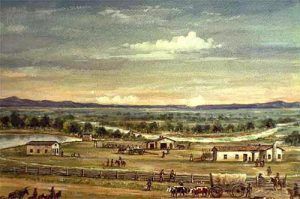
Marcus Whitman founded Waiilatpu Mission in southeastern Washington in 1836. The mission is shown in a painting by William.H. Jackson, 1865.
Between 1836 and 1847, life changed significantly for the Whitmans and the Cayuse. The Cayuse were a semi-nomadic people on a seasonal cycle of hunting, gathering, and fishing. Dr. Whitman introduced agriculture to keep the Cayuse at the mission and introduce Christianity. By the mid-1840s, the mission was also a way-stop on the Oregon Trail. Emigrants traveling to the Willamette Valley knew they could stop at Whitman’s Mission if they needed food, medicine, or a place to stay during the winter. The Cayuse were suspicious of the many people flooding the area, and tensions began to rise between the Indians and the missionaries. The situation came to a breaking point in 1847 with a measles epidemic that, within a matter of months, killed half the Cayuse tribe. Though Marcus was considered a te-wat, or medicine man, to the Cayuse people, his medicines did not work when trying to cure Cayuse infected with measles.
At this time, it was Cayuse tradition that if the patient died after being treated by a medicine man, the patient’s family had the right to kill him. On November 29, 1847, eleven Cayuse took part in what is now called the “Whitman Massacre.” The majority of the tribe was not involved in the deaths of the Whitmans and the eleven emigrants; however, the whole tribe was held responsible until 1850. In that year, five Cayuse were turned over to the authorities in Oregon City and hanged for the crime of killing the Whitmans.
In 1859, Cushing Eells, an associate of Whitman, built the Whitman Seminary on the grounds of the old mission. Later, it was moved to Walla Walla and became Whitman College. The site of Whitman’s death and their mission is now the Whitman Mission National Historic Site run by the National Park Service. This Historic Site preserves the foundation ruins of the mission buildings and the restored irrigation ditch, millpond, and orchard. The Great Grave contains the remains of the 1847 massacre victims.
A visitor center houses artifacts uncovered by archaeologists and interprets the history of the mission and missionary efforts in the Oregon country. The mission is located about seven miles west of Walla Walla, Washington on a short connecting road leading south from U.S. 12.
Compiled and edited by Kathy Alexander/Legends of America, updated December 2021.
Also See:
Sager Orphans on the Oregon Trail
Washington – The Evergreen State
Whitman Massacre National Historic Site
Source: National Park Service

